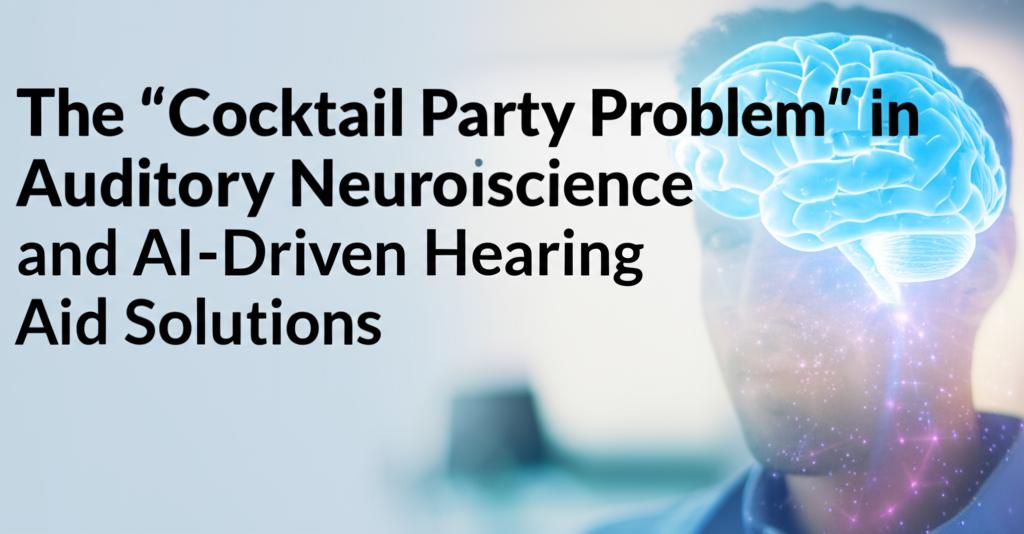The "cocktail party problem" describes the common experience of trying to follow a single conversation in a noisy environment with multiple speakers and background sounds. While human brains are remarkably adept at this, it's a significant challenge for individuals with hearing loss and for traditional hearing aid technology. This article explores the auditory neuroscience behind this phenomenon and the exciting advancements in AI-driven hearing aid solutions aimed at tackling it.
The Neuroscience of Selective Auditory Attention
Our ability to isolate a specific voice amidst a cacophony of sounds is a complex cognitive process known as selective auditory attention. The human auditory system employs several sophisticated mechanisms to achieve this:
- Spatial Separation: Using input from both ears (binaural hearing), our brain can determine the direction of a sound source. This helps us focus on a speaker in a particular location while filtering out sounds from other directions.
- Voice Recognition: We are often able to recognize familiar voices or distinct speech patterns even in noisy settings.
- Contextual Understanding: Our brain is skilled at filling in missing words or parts of speech based on the context of the conversation, aiding comprehension even when the auditory signal is incomplete.
- Inhibitory Neuron Function: Specialized brain cells, known as inhibitory neurons, play a crucial role in suppressing unwanted sounds, acting as a form of internal noise cancellation.
The Challenge for Hearing Aids
Traditional hearing aids often amplify all sounds equally. While this can help with general hearing loss in quiet environments, it can make the "cocktail party problem" even worse. The amplification of all surrounding noises can overwhelm the listener, making it difficult to distinguish the desired speech from the background chatter.
Even more advanced hearing aids with directional microphones and basic noise reduction algorithms struggle in complex acoustic scenarios. These systems are often best at reducing static background noise but falter when multiple people are speaking at similar volumes from different, often close, locations.
AI-Driven Hearing Aid Solutions: A New Era
Artificial intelligence, particularly machine learning and deep learning, is revolutionizing how hearing aids address the cocktail party problem. AI algorithms can learn a user's hearing preferences and automatically adjust settings based on the acoustic environment. Here are some key AI-powered approaches:
- Advanced Noise Reduction and Speech Enhancement: AI algorithms, including Deep Neural Networks (DNNs), are significantly better at distinguishing speech from noise. They can selectively filter out background noise and enhance speech signals, improving clarity and reducing listening effort in noisy situations. Some systems use noise classification, where the AI identifies the type of noise (e.g., traffic, music, chatter) and applies a tailored noise reduction strategy.
- Biologically Inspired Algorithms: Researchers are developing algorithms that mimic the human brain's auditory processing. One such example is the "Biologically Oriented Sound Segregation Algorithm" (BOSSA), developed at Boston University. BOSSA draws inspiration from how the auditory system uses input from both ears to locate and filter sound by location. Early lab tests have shown significant improvements in word recognition accuracy in noisy environments compared to standard hearing aid algorithms. This approach often involves modeling inhibitory neuron activity to suppress unwanted sounds.
- Auditory Attention Decoding (AAD): This cutting-edge technology aims to create "brain-controlled" hearing aids. By analyzing the listener's brainwaves (often measured via EEG), AAD systems can determine which speaker the listener is trying to focus on. The hearing aid then amplifies the attended speaker's voice relative to others. While still a challenging area of research, especially for speaker-independent speech separation, AAD holds immense promise for truly personalized hearing assistance.
- Machine Learning for Personalized Settings: AI-powered hearing aids can "learn" a user's preferences in different sound environments over time. Through observations and user feedback (often via a smartphone app), the device can automatically adjust its settings to provide the optimal listening experience in various situations.
- Own Voice Processing (OVP): Some AI systems can recognize the wearer's own voice and process it separately from external sounds. This addresses a common complaint among hearing aid users about the unnatural sound of their own voice.
- Integration with Other Sensors: Future developments may include integrating eye-tracking technology with hearing aids. This could allow users to direct their listening attention more effectively by simply looking at the person they want to hear.
Current Advancements and Future Directions
Several hearing aid manufacturers have already incorporated AI into their devices, offering features like automatic environmental classification, sophisticated noise reduction, and personalized sound adjustments. Starkey's Livio AI and Evolv AI, Widex's Evoke with SoundSense Learn technology, and Phonak's Audéo Lumity with AutoSense OS™ 5.0 are examples of commercially available hearing aids leveraging AI.
Researchers are continuously working to improve the sophistication of these AI algorithms. The development of more robust neural network models of the auditory cortex and auditory attention is a key focus. Combining visual cues (like lip-reading through AI analysis of video) with auditory information (multimodal AI) is another promising avenue. Furthermore, advancements in hardware, such as improved microphone arrays and on-device processing power, will be crucial for the real-world effectiveness of these AI solutions.
While fully replicating the human brain's ability to solve the cocktail party problem remains a complex challenge, AI-driven hearing aid solutions are making significant strides. These technologies offer the potential to dramatically improve the lives of individuals with hearing loss, enabling them to engage more fully in conversations and social situations, even in the most challenging listening environments. The ongoing research and development in this field promise an exciting future where hearing aids become even more intelligent, adaptive, and attuned to the individual needs of their users.

